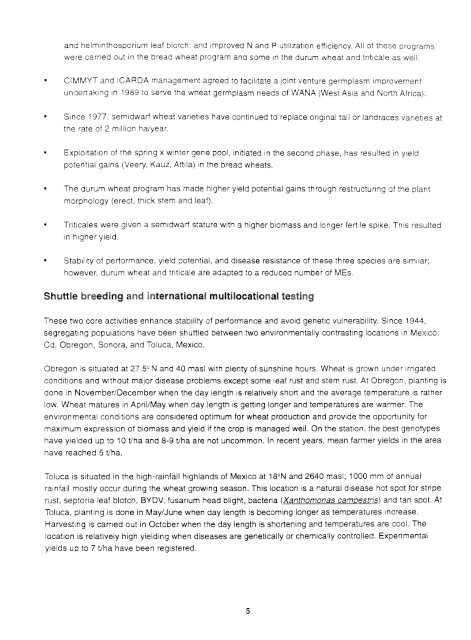Untitled - Search CIMMYT repository
Untitled - Search CIMMYT repository
Untitled - Search CIMMYT repository
You also want an ePaper? Increase the reach of your titles
YUMPU automatically turns print PDFs into web optimized ePapers that Google loves.
and helminthosporium leaf blotch: and improved Nand P utilization efficiency. All of these programswere carried out in the bread wheat program and some In the durum wheat and triticale as well.<strong>CIMMYT</strong> and ICARDA management agreed to facilitate a joint venture germplasm improvementundertaking In 1989 to serve the wheat germplasm needs of WANA (West Asia and North Africa).Since 1977, semidwarf wheat varieties have continued to replace original tailor landraces varieties atthe rate of 2 million ha/year.•Exploitation of the spring x winter gene pool, initiated in the second phase, has resulted in yieldpotential gains (Veery, Kauz, Attila) in the bread wheats.•The durum wheat program has made higher yield potential gains through restructuring of the plantmorphology (erect, thick stem and leaf).•Triticales were given a semidwarf stature with a higher biomass and longer fertile spike. This resultedin higher yield.•Stability of performance, yield potential, and disease resistance of these three species are similar;however, durum wheat and triticale are adapted to a reduced number of MEs.Shuttle breeding and international multilocational testingThese two core activities enhance stability of performance and avoid genetic vulnerability. Since 1944,segregating populations have been shuttled between two environmentally contrasting locations in Mexico:Cd. Obregon, Sonora, and Toluca, Mexico.Obregon is situated at 27.5° Nand 40 masl with plenty of sunshine hours. Wheat is grown under irrigatedconditions and without major disease problems except some leaf rust and stem rust. At Obregon, planting isdone in November/December when the day length is relatively short and the average temperature is ratherlow. Wheat matures in April/May when day length is getting longer and temperatures are warmer. Theenvironmental conditions are considered optimum for wheat production and provide the opportunity formaximum expression of biomass and yield if the crop is managed well. On the station, the best genotypeshave yielded up to 10 tlha and 8-9 tlha are not uncommon. In recent years, mean farmer yields in the areahave reached 5 tlha.Toluca is situated in the high-rainfall highlands of Mexico at 18°N and 2640 masl; 1000 mm of annualrainfall mostly occur during the wheat growing season. This location is a natural disease hot spot for striperust, septoria leaf blotch, BYDV, fusarium head blight, bacteria (Xanthomonas campestris) and tan spot. AtToluca, planting is done in May/June when day length is becoming longer as temperatures increase.Harvesting is camed out in October when the day length is shortening and temperatures are cool. Thelocation is relatively high yielding when diseases are genetically or chemically controlled. Experimentalyields up to 7 tlha have been registered.5

















